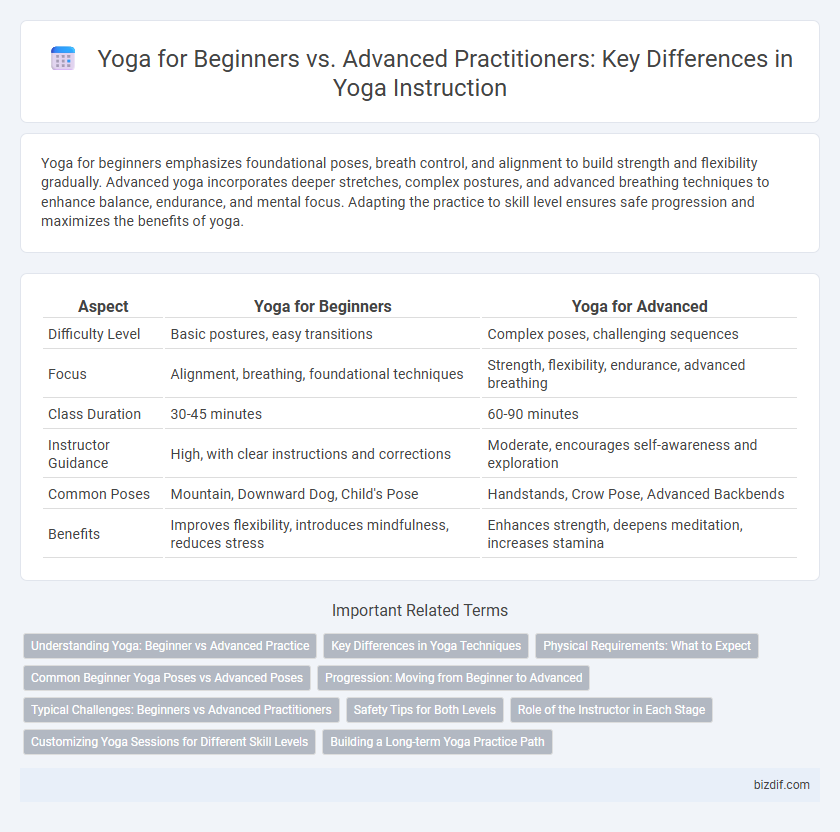Yoga for beginners emphasizes foundational poses, breath control, and alignment to build strength and flexibility gradually. Advanced yoga incorporates deeper stretches, complex postures, and advanced breathing techniques to enhance balance, endurance, and mental focus. Adapting the practice to skill level ensures safe progression and maximizes the benefits of yoga.
Table of Comparison
| Aspect | Yoga for Beginners | Yoga for Advanced |
|---|---|---|
| Difficulty Level | Basic postures, easy transitions | Complex poses, challenging sequences |
| Focus | Alignment, breathing, foundational techniques | Strength, flexibility, endurance, advanced breathing |
| Class Duration | 30-45 minutes | 60-90 minutes |
| Instructor Guidance | High, with clear instructions and corrections | Moderate, encourages self-awareness and exploration |
| Common Poses | Mountain, Downward Dog, Child's Pose | Handstands, Crow Pose, Advanced Backbends |
| Benefits | Improves flexibility, introduces mindfulness, reduces stress | Enhances strength, deepens meditation, increases stamina |
Understanding Yoga: Beginner vs Advanced Practice
Yoga for beginners emphasizes foundational poses, breath control, and building body awareness to establish a safe and effective practice. Advanced yoga practice incorporates complex postures, deeper pranayama techniques, and enhanced flexibility and strength development. Understanding the progression from beginner to advanced practice ensures tailored instruction, injury prevention, and optimized physical and mental benefits.
Key Differences in Yoga Techniques
Yoga for beginners emphasizes foundational poses like Downward Dog and Mountain Pose to build strength, flexibility, and proper alignment, focusing on breath control and balance. Advanced yoga techniques incorporate complex postures such as arm balances and deep backbends, requiring greater flexibility, core strength, and mental concentration. The key differences lie in the intensity, precision, and depth of practice, with advanced yoga demanding enhanced physical conditioning and a deeper understanding of body mechanics.
Physical Requirements: What to Expect
Yoga for beginners typically involves foundational poses that emphasize flexibility, balance, and gentle strength, requiring minimal prior physical conditioning. In contrast, advanced yoga practices demand greater endurance, strength, and flexibility, incorporating complex postures such as arm balances and deep backbends. Beginners should expect a gradual increase in physical demands, while advanced practitioners work towards mastering challenging sequences and enhancing body control.
Common Beginner Yoga Poses vs Advanced Poses
Common beginner yoga poses such as Downward Dog, Child's Pose, and Mountain Pose emphasize foundational balance, flexibility, and breath control, making them accessible for new practitioners. In contrast, advanced poses like Arm Balances (Crow Pose), Inversions (Headstand), and Deep Backbends (Wheel Pose) require greater strength, coordination, and body awareness, challenging even experienced yogis. Mastery of these progressive poses supports injury prevention and deepens the overall yoga practice.
Progression: Moving from Beginner to Advanced
Yoga progression demands mastering foundational poses such as downward dog and mountain pose before advancing to complex asanas like crow pose and handstands. Incorporating breath control techniques and increasing flexibility gradually enable practitioners to build strength and balance essential for higher-level postures. Regular practice, mindfulness, and proper alignment accelerate the transition from beginner to advanced yoga skills.
Typical Challenges: Beginners vs Advanced Practitioners
Beginners in yoga often face challenges such as limited flexibility, difficulty in mastering basic poses, and balancing body awareness with breath control. Advanced practitioners encounter obstacles like achieving deeper stretches, refining complex postures, and sustaining longer practice sessions for enhanced endurance. Both levels require tailored guidance to address these common yet distinct hurdles effectively.
Safety Tips for Both Levels
Yoga for beginners emphasizes foundational poses, proper alignment, and gradual progression to prevent injuries, while advanced practitioners focus on refining techniques and exploring challenging postures with mindful control. Both levels must prioritize listening to their bodies, using props as needed, and avoiding overstretching to ensure safety throughout practice. Establishing a consistent warm-up routine and maintaining awareness of individual limits are essential safety tips for yoga practitioners at any skill level.
Role of the Instructor in Each Stage
The role of the instructor in yoga for beginners centers on building foundational skills, ensuring proper alignment, and fostering a safe environment to prevent injuries. For advanced practitioners, the instructor emphasizes refining techniques, introducing complex poses, and encouraging deeper mindfulness and breath control. Tailoring guidance to skill levels enhances progression and maximizes the benefits of yoga practice.
Customizing Yoga Sessions for Different Skill Levels
Customizing yoga sessions for different skill levels involves tailoring poses and sequences to meet the distinct needs of beginners and advanced practitioners. Beginners benefit from foundational asanas that emphasize alignment and breath control, while advanced yogis engage in more complex postures and dynamic flows to enhance strength and flexibility. Personalized adjustments and modifications ensure safe practice and optimal progress across skill levels.
Building a Long-term Yoga Practice Path
Yoga for beginners emphasizes foundational poses and breath awareness to build strength, flexibility, and mindfulness, establishing a sustainable routine. Advanced yoga practice involves complex asanas, deeper pranayama, and meditation techniques that enhance body control and mental clarity. Progressing from beginner to advanced levels ensures a balanced, long-term yoga path promoting holistic health and continuous growth.
Yoga for Beginners vs Yoga for Advanced Infographic

 bizdif.com
bizdif.com